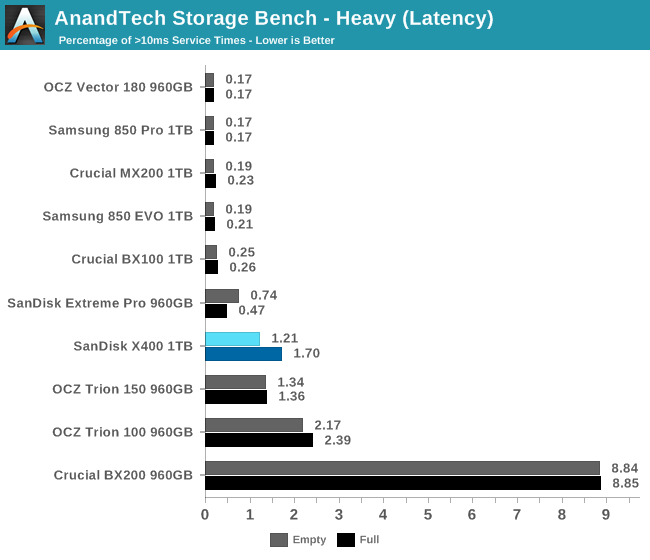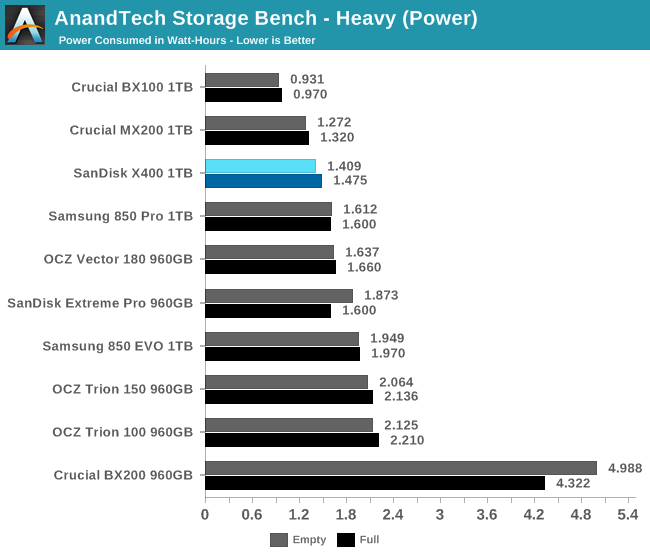The SanDisk X400 1TB SSD Review
by Billy Tallis on May 6, 2016 9:00 AM ESTAnandTech Storage Bench - Heavy
Our Heavy storage benchmark is proportionally more write-heavy than The Destroyer, but much shorter overall. The total writes in the Heavy test aren't enough to fill the drive, so performance never drops down to steady state. This test is far more representative of a power user's day to day usage, and is heavily influenced by the drive's peak performance. The Heavy workload test details can be found here.

Unlike on The Destroyer, the X400 can't quite keep pace with the Crucial MX200 or other MLC drives on the Heavy test, but it is still faster than the other planar TLC drives.

The average service time of the SanDisk X400 on the Heavy test is the best among planar TLC drives, but the TLC drives are all still at the bottom of the ranking by comparison.

The number of latency outliers experienced by the X400 puts it in the same class as the other planar TLC drives, while most of the MLC drives have much tighter control on latency.

As with The Destroyer, the X400 comes in third place for power consumption and overall efficiency, behind the Crucial BX100 and MX200. This is impressive given how write-intensive the Heavy test is and how the the higher power consumption of TLC flash is usually most apparent for write operations.










41 Comments
View All Comments
Chaitanya - Friday, May 6, 2016 - link
1TB capacity in M.2 Form factor is tempting.nathanddrews - Friday, May 6, 2016 - link
I like the $/GB, but there aren't enough GBs.Namisecond - Sunday, May 8, 2016 - link
Maybe you need to stop treating SSDs as bulk storage?dsumanik - Sunday, May 8, 2016 - link
Maybe you should go back to floppies.It's 2016 and there is no reason for magnetic drives to be alive. Yes yes, I know about cost per gig and all the stats you feel like googling and quoting to me to prove how smart you are, but the real truth is this: it's way more profitable to sell us 50 year old technology cuz dums dums will keep on buying.
Bring on xpoint, it'll help push traditional flash down into the bargain bin... And for u sir, Ii will gladly mail you my original dos 6.22 install disks if you simply shut the f**k up.
santeana - Monday, May 9, 2016 - link
LMAO! I wish there was a like button!+1
blakeatwork - Monday, May 9, 2016 - link
It's a process of how quickly do you need to access certain types of data. OS, programs and games all benefit from being on an SSD (assuming supporting architecture does not have any obvious bottlenecks). I'm not sure browsing photos from a recent vacation really provides the necessary strain on your I/O that requires an SSD :DMagnetic drives will stick around for quite a while, especially for Home/SMB NAS devices where the amount of storage is greater then the perceived need for super fast access, which is throttled by GbE network (or WiFi) anyways
bug77 - Tuesday, May 10, 2016 - link
Modern operating system do lots of stuff in the background, an AV may scan your drives from time to time. This is stuff that kills IO on a HDD and that barely registers on a SSD. So there are reason for moving away from HDDs... But yes, the HDD will stick around for a while, simply because of pricing.jordanclock - Saturday, July 2, 2016 - link
Good thing we just dump all old technology as soon as we find a replacement!edward1987 - Thursday, September 22, 2016 - link
1TB is quite out of my pocket £218 (http://www.span.com/product/SanDisk-X400-SSD-SD8SN... but 512GB I would not mind. If you have Qnap tvs-1282 server or similar - they have m.2 for caching or tiered storage. I can use for it in there.HollyDOL - Friday, May 6, 2016 - link
There is a mismatch in Specification table:1TiB (1024GB) should be 1TB(1000GB)
According to specs at https://www.sandisk.com/content/dam/sandisk-main/e...
putting 10^3n and 2^10n prefixes together is just incorrect anyway without correct recalculation...